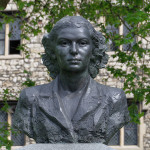
We have all read or seen articles and films on the activities of spies during World War II. Usually these are about the men of MI6 (British), OSS (America), and to a much lesser extent, the Soviet Union’s spy networks (e.g., The Red Orchestra). We’ve recently heard (thanks to declassification) about the wartime contributions of British women in regards to code breaking and Operation Enigma. However, there was a group of young and very dedicated women who were important members of the clandestine British operation called Special Operations Executive (SOE).
The SOE was formed in July 1940 on the orders of Churchill. There is some question by historians as to its effectiveness during the German occupation of European territories but to the SOE agents, their activities were extremely beneficial to the various Resistance movements, especially in France. It was also very dangerous.
The organization was divided up into departments based on the country they operated in. The network in France was code named “F Section.” Women from the First Aid Nursing Yeomanry (FANY) or the Women’s Auxiliary Air Force were recruited for the SOE. A total of 55 women served as agents during the war (39 of them in F Section). Thirteen or one third of the women dropped into France went missing and it was ultimately determined they had been murdered in various Nazi extermination camps. Read More Women Agents of the SOE


